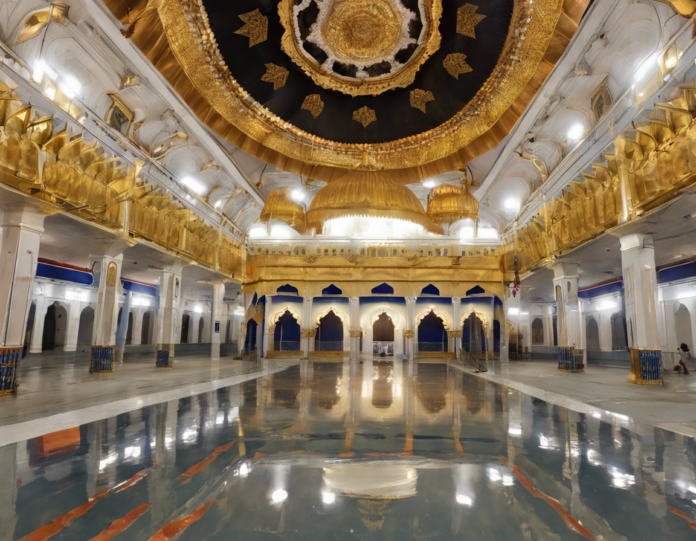Located in the heart of New Delhi, Gurudwara Bangla Sahib stands as a cornerstone of Sikh spirituality and service. This sprawling gurdwara, or Sikh temple, is not only a site of religious significance but also a symbol of selfless humanitarian work. Every day, thousands of devotees and visitors flock to Gurudwara Bangla Sahib to seek solace, offer prayers, and partake in langar, a free community meal. Let’s delve into the history, architecture, practices, and impact of this revered Sikh landmark.
History of Gurudwara Bangla Sahib
Gurudwara Bangla Sahib traces its origins back to the 17th century during the time of the eighth Sikh Guru, Guru Har Krishan Sahib Ji. The land where the gurdwara now stands was once the bungalow (bangla) of Raja Jai Singh, an Indian ruler. It is said that during a smallpox epidemic, Guru Har Krishan Sahib Ji stayed at the bungalow and provided assistance to the suffering. The healing powers attributed to Guru Har Krishan Sahib Ji during this time earned him reverence, and upon his passing, a small tank was consecrated at the site, later developing into the present-day gurdwara.
Architecture and Design
Gurudwara Bangla Sahib features a distinctive architectural style that blends traditional Sikh design elements with contemporary aesthetics. The complex comprises several key structures, including the main prayer hall, a sarovar (water tank), a langar hall, and administrative offices. The gurdwara’s imposing golden dome and white marble facade are iconic features that draw visitors from far and wide.
Upon entering the gurdwara premises, visitors are greeted by the serene waters of the sarovar, which is believed to have curative properties. The main prayer hall, adorned with intricate frescoes and exquisite marble work, resonates with the melodious recitation of Gurbani (Sikh scriptures). The langar hall, a central part of Sikh tradition, serves free meals to all visitors regardless of their background, fostering a sense of equality and community.
Practices and Rituals at Gurudwara Bangla Sahib
Devotees and visitors to Gurudwara Bangla Sahib engage in a range of practices and rituals that hold deep spiritual significance. Some of the key rituals and activities observed at the gurdwara include:
1. Ardas
Ardas, a formal prayer of supplication, is offered by Sikhs as a collective invocation seeking the Guru’s blessings and guidance.
2. Kirtan
Kirtan involves the singing of hymns and devotional songs from the Guru Granth Sahib, accompanied by traditional musical instruments to create a soul-stirring atmosphere.
3. Seva
Seva, or selfless service, is an integral part of Sikhism and is actively practiced at Gurudwara Bangla Sahib. Volunteers participate in various seva activities such as assisting in the langar kitchen, cleaning the premises, and helping with administrative tasks.
4. Guru ka Langar
The langar at Gurudwara Bangla Sahib is a testament to the Sikh principle of community dining. Everyone, regardless of caste, creed, or social status, is welcome to partake in the langar, emphasizing equality and unity.
5. Parikrama
Devotees often perform parikrama, a circumambulation of the sarovar or the main prayer hall, as a mark of reverence and devotion.
Impact and Outreach
Beyond its religious and spiritual significance, Gurudwara Bangla Sahib has made a profound impact through its philanthropic endeavors and community outreach programs. The gurdwara’s charitable initiatives extend to providing free medical services, educational support, and disaster relief efforts. The Guru Harkrishan Sahib Eye Hospital, located within the gurdwara complex, offers state-of-the-art eye care facilities to those in need, reflecting the Sikh values of compassion and service.
Furthermore, Gurudwara Bangla Sahib actively engages in environmental conservation efforts, waste management practices, and sustainable energy solutions to promote eco-friendly initiatives. The gurdwara’s commitment to social welfare and environmental stewardship sets an exemplary standard for sustainable religious institutions worldwide.
FAQ Section
1. Is there an entry fee to visit Gurudwara Bangla Sahib?
No, there is no entry fee to visit Gurudwara Bangla Sahib. The gurdwara welcomes all visitors, irrespective of their religious background, free of charge.
2. Can non-Sikhs participate in the langar at Gurudwara Bangla Sahib?
Yes, the langar at Gurudwara Bangla Sahib is open to everyone, including non-Sikhs. It is a central tenet of Sikhism to serve free meals to all participants as a symbol of equality and unity.
3. What are the visiting hours of Gurudwara Bangla Sahib?
Gurudwara Bangla Sahib is open to visitors every day of the week, from early morning until late in the evening. The precise visiting hours may vary, so it is advisable to check the gurdwara’s official website for updated information.
4. Are there any specific dress code requirements for visitors to Gurudwara Bangla Sahib?
While there is no strict dress code enforced, visitors are encouraged to dress modestly and cover their heads before entering the main prayer hall as a sign of respect. Scarves or head coverings are usually available at the entrance for those who need them.
5. Can visitors participate in the religious ceremonies and rituals at Gurudwara Bangla Sahib?
Yes, visitors are welcome to observe and participate in the religious ceremonies and rituals conducted at Gurudwara Bangla Sahib. It is important to maintain decorum and follow the guidelines set by the gurdwara authorities during these practices.
6. Is photography allowed inside Gurudwara Bangla Sahib?
While photography is generally permitted in the outdoor areas of Gurudwara Bangla Sahib, it is advisable to seek permission before taking photographs inside the main prayer hall or other sacred spaces out of respect for the religious sanctity of the place.
7. Are there guided tours available for visitors at Gurudwara Bangla Sahib?
While formal guided tours may not be available, volunteers and staff members at Gurudwara Bangla Sahib are often willing to provide information and guidance to visitors who wish to learn more about the gurdwara’s history, traditions, and charitable activities.
8. How can one contribute to the charitable initiatives of Gurudwara Bangla Sahib?
Those interested in contributing to the charitable initiatives of Gurudwara Bangla Sahib can do so by offering voluntary donations, participating in seva activities, or volunteering their time and skills to support the gurdwara’s humanitarian projects. Detailed information on donation mechanisms and volunteer opportunities can be obtained from the gurdwara’s administration.
9. Is there parking available for vehicles near Gurudwara Bangla Sahib?
Limited parking facilities are available near Gurudwara Bangla Sahib, although space may be limited during peak hours. Visitors are encouraged to carpool, use public transportation, or avail of nearby parking lots to minimize congestion and ensure a smooth visit to the gurdwara.
10. What are some nearby attractions or points of interest for visitors to explore after visiting Gurudwara Bangla Sahib?
After visiting Gurudwara Bangla Sahib, visitors can explore other landmarks in the vicinity, such as India Gate, Rashtrapati Bhavan, Connaught Place, and various museums and art galleries in central Delhi. These sites offer a rich tapestry of history, culture, and architectural marvels for visitors to immerse themselves in.










